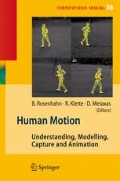The artistic performance literature has much to say about expressive human movement. This chapter argues that powerful, expressive animation tools can be derived from the classic lessons and best practices in this field. A supporting software system for creating expressive character animation is presented that takes advantage of these lessons. To this end, an analysis of the literature was conducted and a set of key aspects of expressive movement were synthesized. To validate the approach, a subset of these aspects is represented computationally as movement properties, or properties for short. These properties provide a set of handles and language for expressing movement. They can be used to write character sketches, which are executable descriptions of a particular character’s movement style. They can also be used to edit and refine an animation. A semantics is provided that describes how the software framework allows these varied properties to be combined in specifying an animation. Examples of character sketches and edits are shown on movements of a standing character.
Access this chapter
Tax calculation will be finalised at checkout
Purchases are for personal use only
Preview
Unable to display preview. Download preview PDF.
References
Alberts D. The Expressive Body: Physical Characterization for the Actor. Heine-mann, Portsmouth, N.H., 1997.
Amaya K., Bruderlin A. and Calvert T. Emotion from motion. Graphics Inter-face ’96, pp. 222-229, 1996.
Barba E. Dilated body. In E. Barba and N. Savarese, editors, A Dictionary of Theatre Anthropology: The Secret Art of The Performer. Routledge, London, 1991.
Barba E. and Savarese N. A Dictionary of Theatre Anthropology: The Secret Art of The Performer. Routledge, London, 1991.
Brand M. and Hertzmann A. Style machines. In Proc. SIGGRAPH 2000, pp. 183-192, 2000.
Chi D.M., Costa M., Zhao L. and Badler N.I. The EMOTE model for effort and shape. In Proc. SIGGRAPH 2000, pp. 173-182, 2000.
Dorcy J. The Mime. Robert Speller, 1961. Translated by Robert Speeler, Jr. and Pierre de Fontnouvelle.
Eisenstein S. On recoil movement. In A. Law and M. Gordon, editors, Mey- erhold, Eisenstein and Biomechanics: Actor Training in Revolutionary Russia. McFarland and Company, Jefferson, North Carolina, 1996.
Gallaher P.E. Individual differences in nonverbal behavior: Dimensions of style. Journal of Personality and Social Psychology, 63(1):133-145, 1992.
Grotowski J. Towards a Poor Theatre. Odin Teatret, 1968. Edited by Eugenio Barba.
Hollars M.G., Rosenthal D.E. and Sherman M.A. SD/FAST User’s Manual. Symbolic Dynamics Inc., 1994.
Hsu E., Pulli K. and Popović J. Style translation for human motion. ACM Transactions on Graphics, 24(3):1082-1089, Aug. 2005.
Kochanek D.H.U. and Bartels R.H. Interpolating splines with local ten-sion, continuity and bias control. Computer Graphics (Proc. SIGGRAPH 84), 18 (3):33-41, 1984. Held in Minneapolis, Minnesota.
Laban R. The Mastery of Movement. Northcote House, London, fourth edition, 1988. Revised by Lisa Ullman.
Lasseter J. Principles of traditional animation applied to 3D computer anima-tion. Proc. SIGGRAPH 87, 21(4):35-44, 1987.
Lawson J. Mime: The Theory and Practice of Expressive Gesture With a De-scription of its Historical Development. Sir Isaac Pitma and Son, London, 1957. Drawings by Peter Revitt.
LeCoq J. The Moving Body: Teaching Creative Theatre. Theatre Arts Books, 2001. with Jean-Gabriel Carasso and Jean-Claude Lallias. Translated by David Bradby.
Liu C.K., Hertzmann A. and Popović Z. Learning physics-based motion style with nonlinear inverse optimization. ACM Transactions on Graphics, 24(3):1071-1081, Aug. 2005.
Moore S. The Stanislavski System: The Professional Training of an Actor. Penguin Books, 1984.
Neff M. and Fiume E. Modelling tension and relaxation for computer anima-tion. In Proc. ACM SIGGRAPH Symposium on Computer Animation 2002, pp. 81-88, 2002.
Neff M. and Fiume E. Aesthetic edits for character animation. In Proc. ACM SIGGRAPH/Eurographics Symposium on Computer Animation 2003, pp. 239-244, 2003.
Neff M. and Fiume E. AER: Aesthetic Exploration and Refinement for expres-sive character animation. In Proc. ACM SIGGRAPH/Eurographics Symposium on Computer Animation 2005, 2005.
Neff M. and Fiume E. Methods for exploring expressive stance. Graphical Models, 68(2):133-157, March 2006.
Perlin K. Real time responsive animation with personality. IEEE Transactions on Visualization and Computer Graphics, 1(1):5-15, 1995.
Pullen K. and Bregler C. Motion capture assisted animation: Texturing and synthesis. ACM Transactions on Graphics, 21(3):501-508, 2002.
Rose C., Cohen M.F. and Bodenheimer B. Verbs and adverbs: Multidimensional motion interpolation. IEEE Computer Graphics and Applications, 18(5):32-40, 1998.
Shapiro A., Faloutsos P. and Ng-Thow-Hing V. Dynamic animation and control environment. Graphics Interface ’05, pp. 61-70, 2005.
Shawn T. Every Little Movement: A Book about Francois Delsarte. Dance Hori-zons, New York, second revised edition, 1963.
Stanislavski C. An Actor Prepares. Theatre Arts, 1936. Translated by Elizabeth Reynolds Hapgood.
Stanislavski C. Building a Character. Theatre Arts Books, 1949. Translated by Elizabeth Reynolds Hapgood.
Stanislavski C. Creating a Role. Theatre Arts Books, 1961. Translated by Elizabeth Reynolds Hapgood.
Tarver J. and Bligh K. The physical art of the performer, 1999. Workshop: A 30 hr. intensive introduction to Laban and Grotowski held at the Nightwood Theatre studio, Toronto.
Taylor G. Francois Delsarte: A codification of nineteenth-century acting. Theatre Research International, 24(1):71-81, 1999.
Thomas F. and Johnston O. The Illusion of Life: Disney Animation. Abbeville Press, New York, 1981.
Unuma M., Anjyo K. and Takeuchi R. Fourier principles for emotion-based human figure animation. Proc. SIGGRAPH 95, pp. 91-96, 1995.
Wiley D. and Hahn J. Interpolation synthesis of articulated figure motion. IEEE Computer Graphic and Applications, 17(6):39-45, 1997.
Wooten W.L. Simulation of Leaping, Tumbling, Landing and Balancing Hu-mans. Ph.D. dissertation., Georgia Institute of Technology, 1998.
Author information
Authors and Affiliations
Editor information
Editors and Affiliations
Rights and permissions
Copyright information
© 2008 Springer
About this chapter
Cite this chapter
Neff, M., Fiume, E. (2008). From Performance Theory to Character Animation Tools. In: Rosenhahn, B., Klette, R., Metaxas, D. (eds) Human Motion. Computational Imaging and Vision, vol 36. Springer, Dordrecht. https://doi.org/10.1007/978-1-4020-6693-1_24
Download citation
DOI: https://doi.org/10.1007/978-1-4020-6693-1_24
Publisher Name: Springer, Dordrecht
Print ISBN: 978-1-4020-6692-4
Online ISBN: 978-1-4020-6693-1
eBook Packages: Computer ScienceComputer Science (R0)

